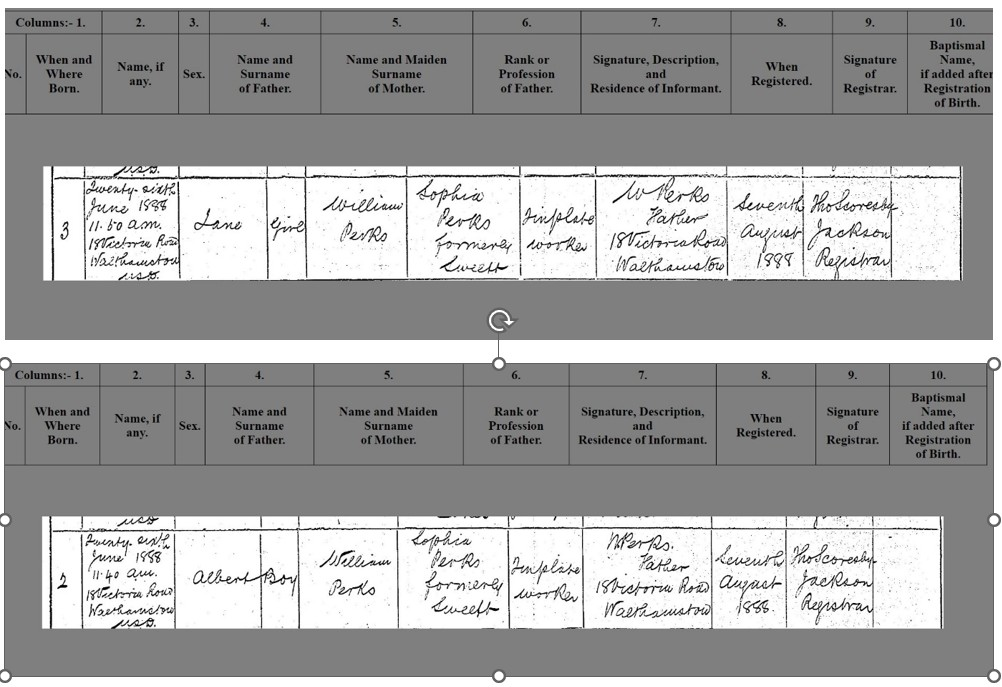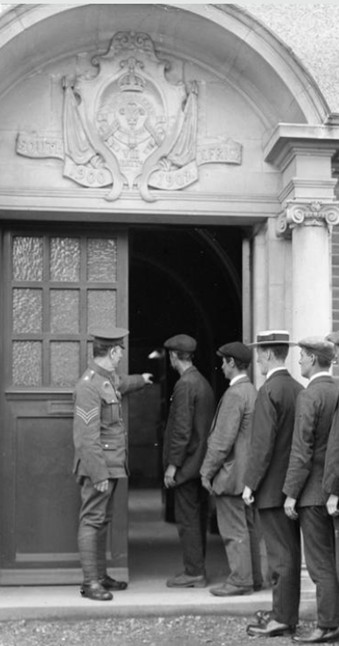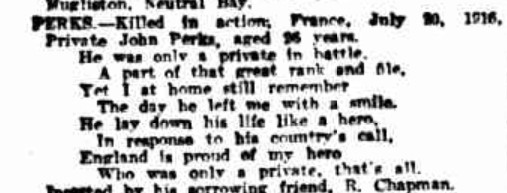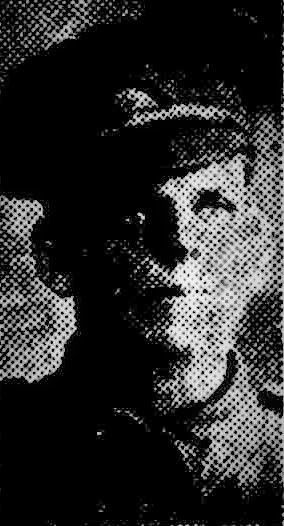
Albert John PERKS
Eyes grey, Hair dark, Complexion dark
John Perks – A treasured friend
Can you help us identify John?
After the battle, German soldiers recovered and buried the bodies of hundreds of Australian and British casualties. Among them were at least 250 Australian soldiers, interred by the Germans in a large mass grave behind the lines at Pheasant Wood, near the village of Fromelles.
Since then, an international effort has been underway to identify the soldiers using a combination of DNA testing, dental analysis, and military records. As of 2025, 180 of the 250 soldiers have been positively identified — including 26 from the 30th Battalion, the same unit as John.
Although John Perks has not yet been formally identified, there is renewed hope. Family members have come forward, and DNA reference samples have been provided. This is a crucial step toward a possible identification in the future.
Albert John Perks, known as John, was born on 26 June 1888 in Walthamstow, Essex, England. He was one of twins, born to William Perks (1851–1930), a tinplate worker, and Sophia Sweett (1853–1890). Tragically, Sophia died in 1890 when John and his twin sister Jane were not yet two years old.
In 1892, William remarried Frances Shakeshaft, who helped raise the children and remained with the family for many years. The 1911 Census shows William and Frances still together in Upper Edmonton, London, with some of the adult children nearby.
John came from a large working-class family in East London. He had seven siblings, although two died in infancy. His older brothers William, Charles, and Edwin were all involved in trades — including tinplating and metalwork — and his sister Sophia worked as a servant in Hackney. The Perks family lived in a modest home and were among the many London families who struggled to make ends meet.
At some point around 1910, John made the life-changing decision to emigrate to Australia. He settled in Tempe, New South Wales, where he lived at 6 Johns Street and continued to work as an electroplater. Though far from home, John formed a strong friendship with Miss Ruby Chapman, who would later describe herself as his only friend in Australia.
By the time of his enlistment in 1915, only five of John’s siblings were still living, William, Charles, Edwin, Sophia, and his twin, Jane. His brother Charles followed him to Australia, arriving in Melbourne in 1915. John’s service and sacrifice would leave a lasting impression on both continents.
The children of William and Sophia were:
- William George Perks, 1876–1926 m Margaret Speer
- Charles Thomas Perks, 1878– to Australia 1915
- Edwin Perks , 1880–1964 unmarried (probate to Bray)
- George Perks, 1882–1888 died infancy
- Sophia Florence Perks, 1883–1969 servant in Hackney 1901
- Louisa Perks , 1886–1889 died infancy
- Jane Perks twin, 1888–1974 m Henry E W Bray 1915
- John (Albert John) Perks twin 1888–1916
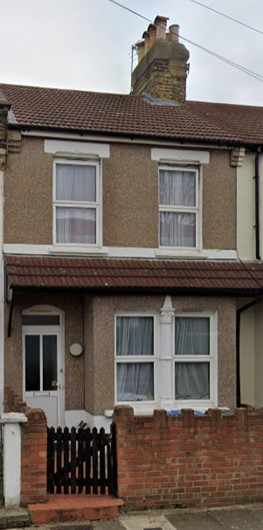
John followed his father and brothers into metalwork. He trained as an electroplater — a profession that aligned with the family’s background in tin and metalwork.
He also joined the British Army, serving three years in the 8th Battalion, Middlesex Regiment, based at Hanworth Road, Hounslow. This experience gave him valuable military training that would later shape his service in the AIF.
Off to War
John enlisted in the AIF on 12 July 1915 at Liverpool, New South Wales. He was 27 years old, working as an electroplater, and living in the Sydney suburb of Tempe. Following his enlistment, John was allocated to C Company of the newly formed 30th Battalion, part of the 8th Brigade of the 5th Australian Division. Training commenced at the Liverpool Camp before the battalion transferred in early September to the Royal Agricultural Society Grounds at Moore Park in Sydney for final preparations. It was here that the 30th Battalion began to bond as a fighting unit, made up of men from New South Wales and Victoria.
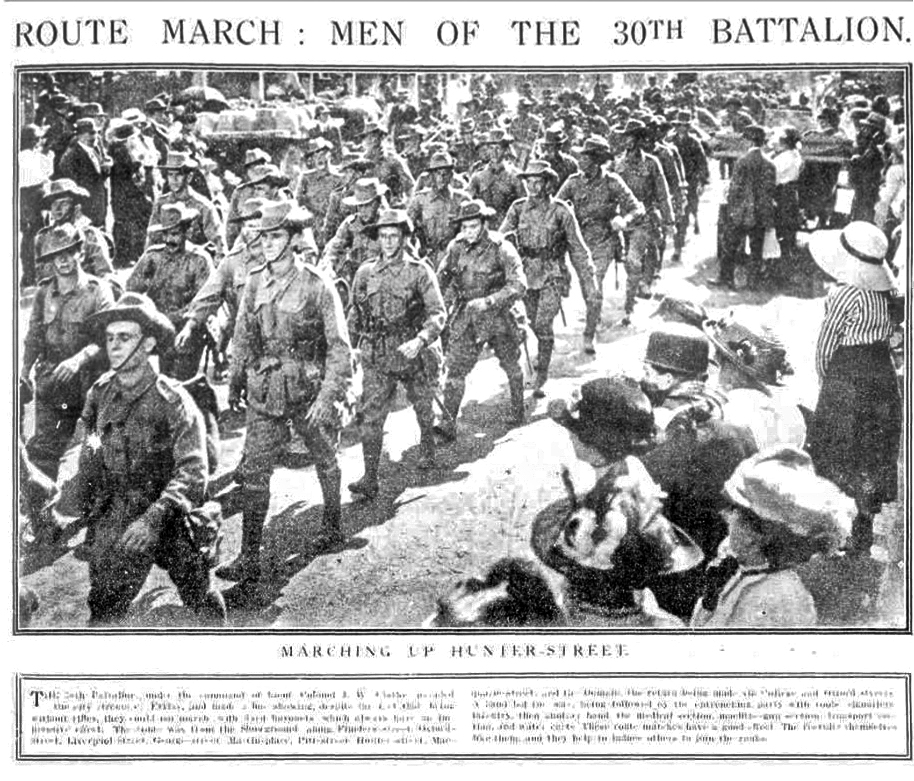
On 9 November 1915, John and his battalion embarked from Sydney aboard HMAT A72 Beltana. After a month-long sea voyage, they arrived in Egypt and disembarked at Suez on 11 December. The men travelled by train to Helmieh and marched to Aerodrome Camp at Heliopolis, on the outskirts of Cairo. For the first weeks, John was stationed at Ferry Post, guarding the Suez Canal and undergoing military training. In February and March 1916, the battalion moved to Tel el Kebir, a sprawling camp site and training ground where the men were reviewed by His Royal Highness, the Prince of Wales. Training focused on musketry, entrenching, and trench assault tactics in preparation for the Western Front.
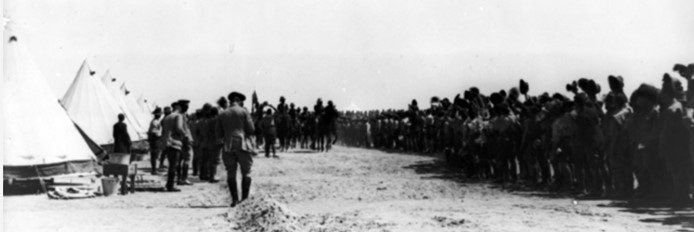
During April and May, John and his comrades returned to Ferry Post and spent time rotating through the front-line trenches along the Canal defences. Letters home from the men mention the harsh conditions — heat, flies, and poor water supply — but morale remained high as the battalion prepared for deployment to Europe. On 16 June 1916, the 30th Battalion departed Alexandria aboard the transport ship Hororata, bound for France. The battalion had disembarked at Marseilles on 23 June, then endured a grueling 60-hour train ride north to Hazebrouck, before being billeted near Morbecque. Training resumed — now under the constant thunder of artillery from the nearby front. Private F.R. Sharp (2134), a fellow soldier in the 30th Battalion, wrote home:
“From the time we left Marseilles until we reached our destination was nothing but one long stretch of farms and the scenery was magnificent… France is a country worth fighting for.”
Fromelles
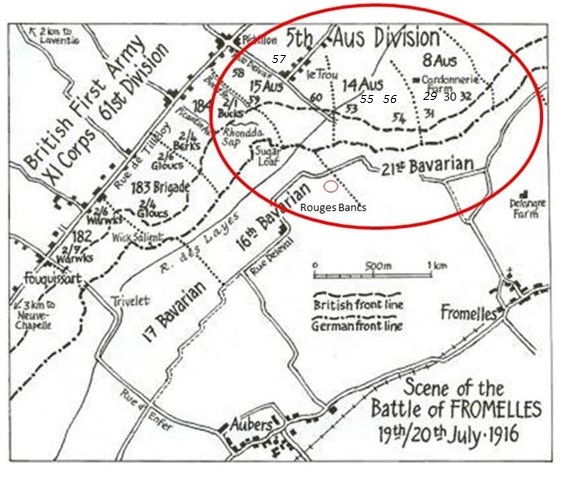
Only weeks after arriving in France, the 30th Battalion was ordered into its first major engagement on the Western Front fought on 19–20 July 1916. As they moved closer to the front, the 30th Battalion marched 20 kilometres to Estaires, then another 11 kilometres to Erquinghem, finally billeting at a farmhouse known as “Jesus Farm.” From here, they moved in and out of the trenches to acclimatise and prepare for action. On 10 July at 9.00 PM, they entered the front-line trenches near Fleurbaix, getting their first direct exposure to warfare on the Western Front. The 30th Battalion formed part of the 8th Brigade, 5th Division, alongside the 31st and 32nd Battalions.
While the main assault was to be led by the 31st and 32nd Battalions, the 30th was initially tasked with a supporting role — digging new communication trenches, carrying ammunition, and preparing to escort prisoners. They were to reinforce only if absolutely necessary. By 19 July, all units were in position. The Australian artillery barrage had been pounding German positions for days, but it failed to destroy key strongpoints or suppress German machine-guns. Zero Hour was set for 5.45 PM.
At 5.53 PM, the 32nd Battalion went over the top, followed by the 31st at 5.58 PM. The Germans, who had anticipated the attack, unleashed a ferocious storm of machine-gun and artillery fire. Despite heavy casualties, Australian soldiers reached the enemy’s first line trench — Trench B — which one soldier described as:
“Practically a ditch with from 1 to 2 feet of mud and slush at the bottom.”
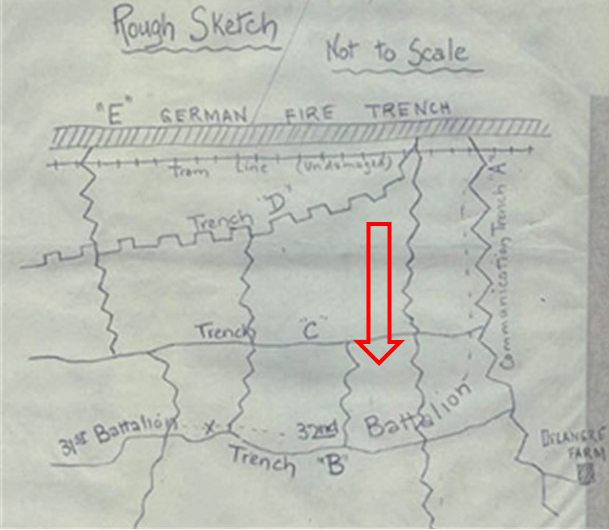
Back in the reserve lines, John’s unit — C Company, 30th Battalion — was awaiting orders. But as casualties mounted among the lead battalions, and gaps in the line appeared, the situation changed rapidly. Brigade commanders gave the order, the 30th was to move forward as reinforcements. The battalion that had been intended as support was now thrust into combat. This sudden shift disrupted the entire operational flow. The 30th’s men, including those carrying ammunition or digging trenches, were now fighting to hold captured positions. The battalion became involved in the front-line struggle alongside the 31st and 32nd.
At 10.10 PM, Lieutenant-Colonel Clark of the 30th reported:
“All my men who have gone forward with ammunition have not returned. I have not even one section left.”
Throughout the night, fighting raged. Some units pushed further, attempting to reach the second German trench system. But they lacked grenades, had limited artillery support, and were exposed to machine-gun fire not just from the front — but from their flanks and rear, especially from Delangre Farm, which had not been captured.
The 30th Battalion fought to hold the captured trenches, now under constant bombardment. At 4.00 AM on 20 July, the Germans launched a counter-attack on the Australians’ left flank. German troops bombed their way through Trench A and exploited weaknesses in the rear line — particularly Trench E, which had been left nearly empty to feed the advance. By 5.30 AM, the Germans were attacking from both flanks. The exhausted Australians were dangerously exposed. Many had only rifles remaining to defend themselves. The situation was chaotic. According to the 31st Battalion War Diary:
“The enemy swarmed in and the retirement across No Mans’ Land resembled shambles, the enemy artillery and machine guns doing deadly damage.”
By 10.00 AM, it was over. The Australians were forced to withdraw. Despite gallant efforts, the objectives had not been held. No territorial gains were made, and the cost in lives was catastrophic. Though intended to support from behind the lines, the 30th Battalion lost 122 men, 54 killed, 230 wounded, and 68 missing. Among the missing was John. In the months and years following the battle, families waited for word of their sons.
But no grave was ever found for John. When Charles Bean, Australia’s official war historian, visited the battlefield two and a half years later, he still found bones, torn uniforms, and scattered Australian equipment lying where the Australians had fallen.
After the War
John’s name appeared in casualty lists and memorial rolls, but no burial location was ever confirmed. There is no known Red Cross Wounded and Missing file for him — an absence that has made tracing his fate all the more difficult.
In the years following the battle, one name appeared repeatedly in correspondence with Base Records, Miss Ruby Chapman. Ruby described herself as John’s only friend in Australia, and she wrote several letters seeking news of what had become of him.
In one reply, Chaplain F. Ward acknowledged her inquiry and expressed his sorrow, stating that John had been killed in action during the fighting in France. Ruby continued her inquiries, hoping for further detail — a burial location, a witness, or confirmation — but none came.
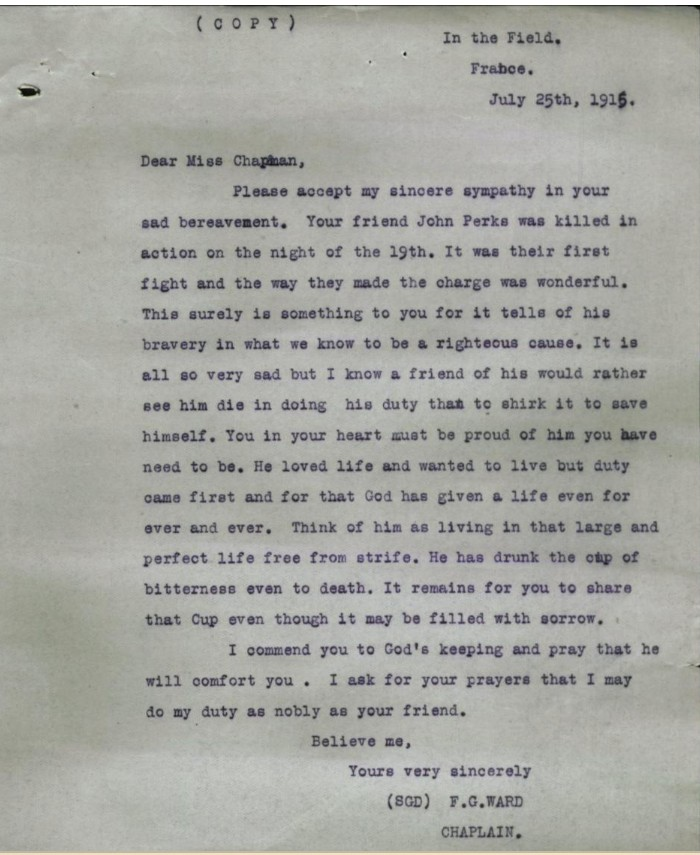
John’s medals — the 1914–15 Star, British War Medal, and Victory Medal — were issued posthumously, along with a Memorial Plaque and Memorial Scroll to his father, William Perks, who was still living in Upper Edmonton, London, well into the 1920s.
Today, John is commemorated at the V.C. Corner Australian Cemetery and Memorial, located near the battlefield at Fromelles. His name appears on Panel 3, alongside over 1,200 other Australian soldiers who died in the battle and have no known grave.
Can John Be Found?
After the battle, German soldiers removed 250 Australian casualties from the battlefield, burying them in a large pit near Pheasant Wood. This mass grave was not discovered until 2008. Identification by DNA matching has been ongoing since that discovery as potential relatives have been found. To date (2025), 180 of the 250 soldiers from the grave have been identified, including 26 of the 80 missing soldiers from the 30th Battalion.
Family connections are sought for the following soldier
| Soldier | Albert John Perks (1888–1916) |
| Parents | William Perks (1850–1930) of Edmonton, Essex and Sophia Sweett (1853–1890) |
| Siblings | William George Perks (1876–1926) m Margaret Speer | ||
| Charles Thomas Perks (1878–?) – migrated to Australia 1915 | |||
| Edwin Perks (1880–1964), unmarried | |||
| George Perks (1882–1888), died in infancy | |||
| Sophia Florence Perks (1883–1969), servant in Hackney 1901 | |||
| Louisa Perks (1886–1889), died in infancy | |||
| Jane Perks (1888–1974), twin, m Henry E. W. Bray 1915 |
| Grandparents | |||
| Paternal | William Perks (1829–c.1885) and Jane Shave (1829–c.1900) | ||
| Maternal | Thomas Sweett (1817–1880) and Elizabeth Fish (1817–1880) |
Seeking DNA Donors

Contacts
(Contact: carla@fromelles.info or geoffrey@fromelles.info).
(Contact: army.uwc@defence.gov.au or phone 1800 019 090).
Donations
If you are able, please contribute to the upkeep of this resource.
(Contact: bill@fromelles.info ).
